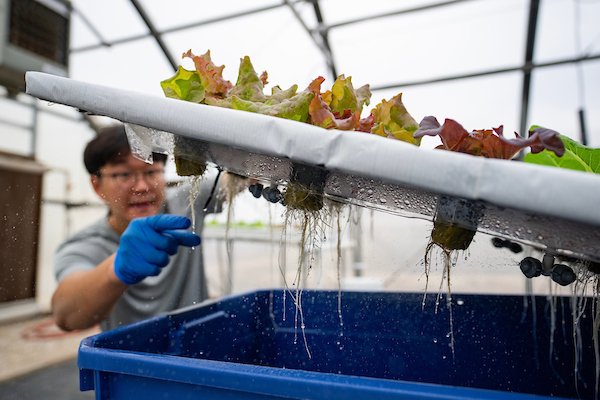The Winter Garden region of Texas lives up to its name.
This region, which includes seven counties between San Antonio and Laredo, is home to some of the most thriving horticultural production in the state.
Winter gardens boast excellent growing conditions for vegetable crops such as spinach, potatoes, onions, cabbage, and other vegetables, as well as fruits such as watermelons, melons, specialty peppers, strawberries, and pecans.
In recent years, producers have faced challenges such as water availability, crop disease, and labor shortages. The Texas A&M College of Agriculture and Life Sciences’ Department of Horticultural Sciences is committed to helping horticulture businesses overcome these challenges and find opportunities.
Texas A&M AgriLife research scientists in the College of Horticultural Sciences and Texas A&M AgriLife Extension Service specialists conduct research to improve the competitiveness of global producers through innovation and improved economic and environmental sustainability. We strive to develop and provide knowledge and advances based on
Horticulture operations in the Winter Garden area produce a variety of fruits and vegetables, including cabbage, peppers, and pecans. (Sam Craft, Michael Miller, Laura McKenzie/Texas A&M AgriLife)
Leading the way in horticultural research across the winter garden is the Texas A&M AgriLife Research and Extension Center in Uvalde. The center is one of 13 regional Texas A&M AgriLife Research and Extension Centers operating across the state to conduct research and provide region-specific expertise.
“Winter garden horticulture operations play a critical role in fruit and vegetable productivity in Texas,” said Dr. Amit Dhingra, director and professor of horticultural science. “The department continually seeks solutions and opportunities to improve the economic and environmental sustainability of horticultural producers as they strive to provide high-quality, nutritious crops. ”
Collaborative science paves the way to sustainable horticulture
Dr. Daniel Leskover, center director and director of controlled environment horticulture at the Texas A&M AgriLife Research Extension Center in Uvalde and Dallas, said research conducted at the Uvalde center focuses on impacts.
Dr. Daniel Leskovar, director of the Texas A&M AgriLife Center in Uvalde and professor of vegetable physiology in the Department of Horticultural Sciences, stands in a research greenhouse filled with tomato plants. (Sam Craft/Texas A&M AgriLife)
Lesková said impactful research requires cross-disciplinary collaboration between scientists in the Department of Horticultural Sciences and scientists in the Department of Agricultural and Life Sciences and other national and international institutions and institutions. .
Faculty members in the Department of Horticultural Sciences include Dr. Vijay Joshi, associate professor and plant systems physiologist with AgriLife Research, Dr. Larry Stein, professor and Regents Fellow, horticulture specialist with AgriLife Extension; Includes scientists from AgriLife Research. and vegetable breeder Dr. Subhash Malla, all based in Uvalde.
“Our research shows that it is valuable in terms of how it can lead to sustainable and resilient horticultural systems,” he said. “It means fewer inputs, such as water, are needed to produce the food we need, how that food provides nutrition, the opportunities afforded to producers in the marketplace, and how much more that crop leaves the farm. It means everything in the overall economic and environmental context of getting it to the table.”
A holistic approach to stakeholder needs
The centre’s collaborative projects span scientific fields, as researchers explore solutions related to plant management from seed to harvest.
The research led by Malla is the epitome of collaborative science.
One of Malla’s research is a $5.2 million project focused on mechanically harvesting sweet onions for the wet market. This interdisciplinary project combines mechanical engineering, best crop management practices and plant genetics to find solutions to labor shortages, an ongoing problem for growers.
Dr. Subhash Mara is part of the Texas A&M Horticultural Sciences faculty team based in Uvalde. Their work supports growers in the Winter Garden region and around the state. (Sam Craft/Texas A&M AgriLife)
Mara collaborates with Weslaco’s Stein, Professor, Regents Fellow, Associate Dean Dr. Juan Anciso, Professor Emeritus of the Department of Bioagricultural Engineering Dr. Stephen Searcy, and Dr. Francisco Abello. .D., AgriLife Extension Economist in the Vernon Bureau of Agricultural Economics.
“This project is a great example of a holistic approach to helping producers adapt,” Mara said. “We are deeply engaged with our stakeholders, which helps us understand their needs and how we can address them with science and technology.”
Ever-evolving horticultural science
Leskovár is involved in several innovative projects. The content varies, but the goal is to improve yield and fruit quality of high-value crops such as tomatoes and peppers.
One project is testing how grafting plant varieties can reduce the impact of pests and diseases and improve tolerance to stresses such as drought and heat. Other studies are investigating how plants perform in different production environments, such as open fields, hydroponic systems, or tall tunnel hoop houses.
Research in Uvalde also includes testing plants within a controlled environmental cultivation system to optimize production efficiency. (Sam Craft/Texas A&M AgriLife)
Optimizing crop productivity and the use of resources such as water is an important part of the research, Lesková said. Changes in climatic conditions in recent decades have increased stress on crops, including heat, drought, and water availability. Therefore, improving varieties of vegetables and fruits that are resistant to heat and can use water more efficiently has become an important research element.
Leskovar and other researchers at the center continue to push the boundaries of horticultural science throughout the food chain, from plant protection to crop productivity to post-harvest food safety. A synergistic approach to scientific solutions will ensure that consumers have access to safe, nutritious and reliable horticultural crops grown in the winter garden and across the state.
“This type of research is a very dynamic, never-ending process,” Leskovar said. “Food production is challenged by weather, disease, pests, and other factors. But fruits and vegetables are essential to human health and nutrition, and our efforts connect directly to consumers’ plates. So it’s a very rewarding job.”

